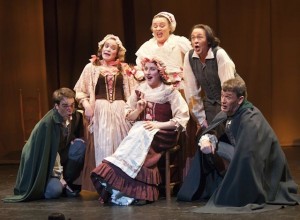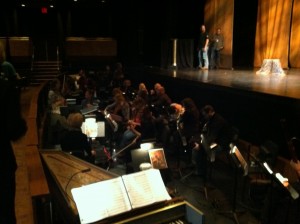Friday, January 20, 2012 7 PM
The Atlas Performing Arts Center
The presence of an art center is a known catalyst for the renaissance of a neighborhood on the down and outs. It attracts peaceful, benign folks (artists, families) ; it fertilizes parallel businesses like restaurants, and when well considered, it serves the community, from young to old. The Atlas is a perfect example. Opera Lafayette chose the Atlas as a rehearsal home many years ago and the members of the orchestra have watched the community move from slightly frightening to delightening! The staff at the Atlas welcomes us with smiles and a willingness to do whatever they can to make our work comfortable, successful. Not Bad!
The Art Deco theater building has been divided up into studios for dancing, music, and art with a black box theater and the original theater. Opera Lafayette offers school programs and a preview (dress rehearsal) program regularly.
No matter now generous and welcoming, there are certain givens that can’t be denied. The rehearsal rooms are terribly dry in winter and can pose dangers for our fragile and old wood instruments. There is an ever-present white noise from an institutional air system that wasn’t designed for silence. This can make rehearsals more laborious as we need to hear ourselves through the blower hum. And I have, in a previous entry, described the theater’s pit.

The acoustics of the hall are dull, dead, and work against the sounds of our old instruments, strung with gut strings. You may know that Baroque instruments are considerably quieter than conventional instruments used for classical music. While they don’t have volume (amplitude), they have color. The looser strings allow for more complicated vibration patterns when put into play and a much richer overtone series. These fragile partials or overtones can only be heard with a live acoustic and are entirely lost when a hall is dry. Think of the music rooms of any Venetian villa or French chateau…not dry! In the private rooms of Mme de Maintenon or Pompadour, our instruments shimmer with beauty and fill the ear lush perfumed sound.
Our performances at the Atlas are usually preceded by long rehearsals on the same day and we are wilted before we play the overture for the audience. All told, this is not a recipe for satisfaction but it is an ideal way to perform the work in its entirety under demanding circumstances and make final notes in our minds on what needs to be corrected or considered before “opening night”.
Our performance is to a full house! Tickets to the the Kennedy Center’s performance have been sold out for quite a while so many people are grabbing the opportunity to hear Monsigny at the Atlas. In the pit, we hear little of the singing, and can hear the muffled sound of audience response that includes some laughter and applause, also muffled from our “under the floor” location. We go away thinking, “Maybe this is good…. gosh we are tired!”
Saturday, January 21, 2012 7:30 PM
The Terrace Theater, The Kennedy Center
Playing at the Kennedy Center is an event. There are long public halls decorated with flags and littered kiosks, there is the good café dinner after the warm up rehearsal and before the performance and all this sets us up for an event, a memorable one. There is something 1960’s Gothic fortress about the complex with large halls leading from chapel to chapel (or concert hall to concert hall as the case is here). Ten years ago I would have said that the place had no flavor but now, in 2012, the sixties are becoming tasty again. To help, both the Kennedy Center and Lincoln Center have designed ways and made efforts to redefine the relationship between the buildings and the city around them. For the Kennedy Center, it was acknowledging the beautiful river that flows by, for Lincoln Center, opening up the sides of the campus to pedestrians to enjoy new access either in front or side or back.
When you enter the Terrace Theater to take your seats in the audience, there is the impression of looking into a telescope from the wrong end. The hall is steeply raked and the stage appears far though it is not far at all. The hall seats between 400 and 500, a perfect size for listening to Baroque and Classical music. The acoustics of the Terrace Theater are quite good and for the first time, we hear the work in a room that supports or efforts because it magnifies the beauty of the instruments.
Our dress rehearsal reminds us that the pit at the Terrace is not much better than the Atlas pit and though I don’t see them, Ryan Brown tells me that he has seen Decon traps in the stairwell. The pit is crowded though less coffin like. The contact with the stage is no better but we are able to hear and see the audience and can be encouraged by their responses. And the responses are vibrant, appreciative and engaged. The sound that we hear is fine and when the performance is over we think, “This must be good, the audience seemed to love it, gosh are we tired!”
Thursday, January 26, 2012 7:30 PM
The Rose Theater, Jazz at Lincoln Center
Before we arrive in New York City we have recorded the opera at the University of Maryland (more on that in the next blogs) and we know the score back and forth! We have made many takes of each musical number and have explored so many more possibilities for performance that we are all free and more masterful in our roles. We seem to know exactly what Ryan Brown wants and, without a question, we are primetime material.
The theaters for Jazz at Lincoln Center are housed in the Time Warner Buildings on Columbus Circle at the southwest corner of Central Park and in the lively middle of Manhattan. The building’s construction caused so much consternation on the part of the community with concerns about limited sunlight entering the park because of the towers. And though these concerts are completely legitimate, the complex is a vibrant modern medina, a market place that attracts people into the buildings. In its four stories of retail space I find that I want to eat at every restaurant, buy at every store, and say hello to every passerby. It is a great experience of America’s still greatest city. On the 5th floor, crowning this epic of conspicuous consumption are two magnificent performance spaces, and the Rose Theater might well be New York’s most successful and attractive concert hall.

The pit is uncovered and from it we can see the entire stage, the audience and this beautiful modern opera house. Though not perfect in size, we squeeze ourselves into the playing space. We are finally allowed to be fully aware of every corner of our show. There is some problem hearing across the orchestra and the bass sections try with difficulty to make out the filigree work of the violinists however, we hear the singers and watch the action on stage when we are not accompanying the arias. We see the audience and hear the full extent of their approval. The acoustic of the hall is ideal.
The lighting for the production is handled professionally and our senses are heightened from the opening E Flat octaves of the Overture to the last C major chord of the opera.
When we are done we think, “This was great, they loved it, I think it’s a wonderful show, Gosh we are tired.”




Leave a Reply